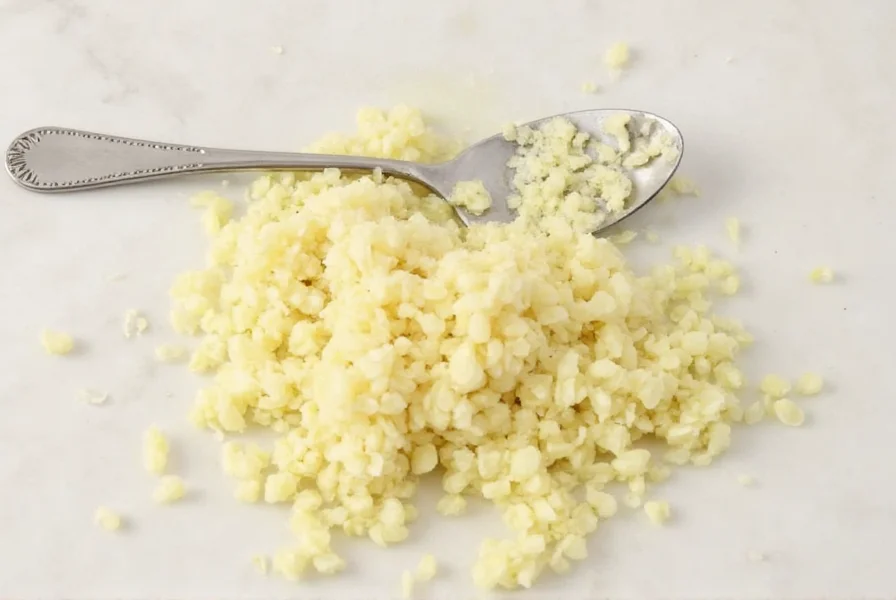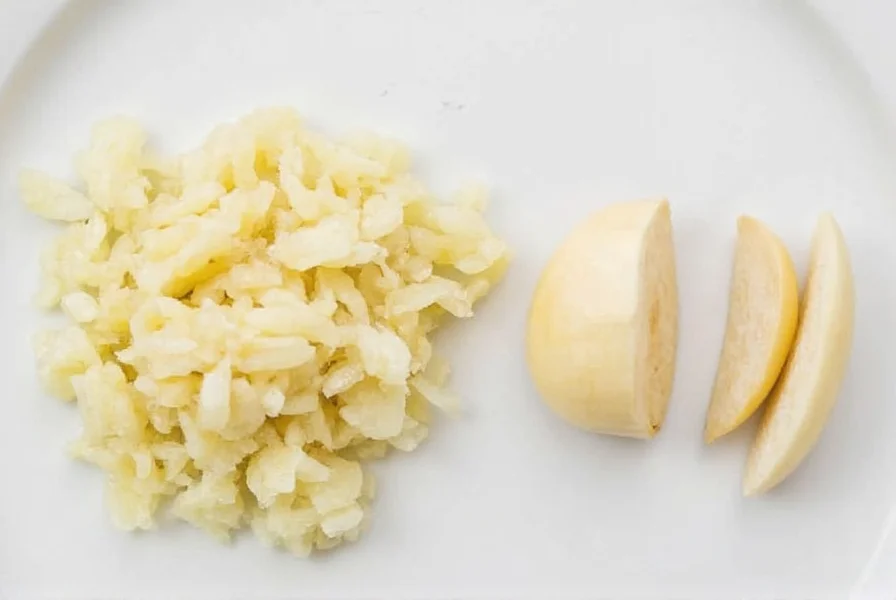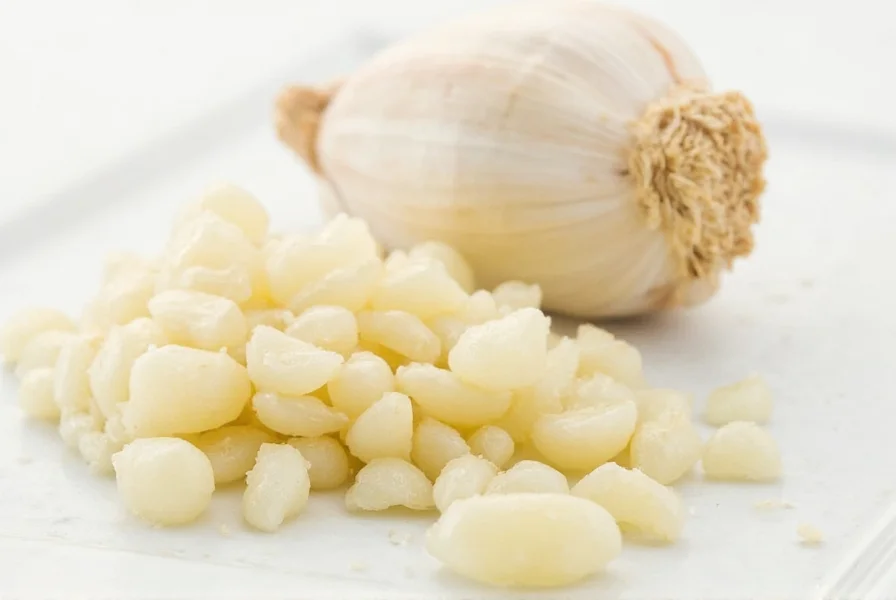Understanding garlic measurements is essential for perfecting recipes without overpowering dishes. Whether you're working with fresh cloves or pre-minced alternatives, getting the proportions right affects both flavor balance and cooking success.
Garlic Measurement Guide: Cloves to Minced Conversions
Garlic size varies significantly between varieties and growing conditions, which impacts the minced yield. Here's a detailed conversion chart for different clove sizes:
| Garlic Clove Size | Dimensions | Minced Yield | Teaspoons | Tablespoons |
|---|---|---|---|---|
| Small | < ¾ inch long, < 3/16 inch diameter | Light 1/2 tsp | 0.5 | 1/6 |
| Medium (standard) | 1 inch long, ¼ inch diameter | Firm 1½ tsp | 1.5 | 1/2 |
| Large | 1¼ inches long, 5/16 inch diameter | 2–2½ tsp | 2.25 | 3/4 |
| Jumbo | 1½+ inches long, 3/8+ inch diameter | 3+ tsp | 3.5 | 1¼ |
Factors That Affect Minced Garlic Measurements
Several variables influence how much minced garlic you'll get from a single clove:
Clove Size Variability
Garlic bulb varieties differ dramatically in clove size. Softneck garlic typically has smaller cloves than hardneck varieties. Within a single bulb, outer cloves are usually larger than inner ones. When recipes specify "one clove," they generally mean a medium-sized clove unless otherwise noted.
Mincing Technique Matters
Your mincing method affects volume:
- Hand-minced: Produces slightly more volume due to uneven pieces
- Microplane: Creates denser mince with less air between particles
- Food processor: Can create a paste-like consistency with less volume
Moisture Content Differences
Freshly harvested garlic contains more moisture than cured garlic, affecting both weight and volume. Garlic stored for several months becomes drier and yields slightly less minced product.
Practical Recipe Substitution Guide
Knowing how to convert between whole cloves and minced garlic helps when adapting recipes:
When Substituting Minced for Whole Cloves
Use this conversion in recipes calling for whole cloves that will be minced during preparation:
- 1 medium clove = 1½ tsp minced garlic
- 3 cloves = 1 tablespoon minced garlic
- 6 cloves = 2 tablespoons (1/8 cup) minced garlic
- 12 cloves = 1/4 cup minced garlic
Using Pre-Minced Garlic from Jars
Bottled minced garlic contains preservatives that slightly alter flavor intensity. When substituting:
- Use 1 teaspoon bottled minced garlic per medium fresh clove
- Reduce by 25% compared to fresh minced garlic measurements
- Add near the end of cooking to preserve flavor

Professional Cooking Tips for Garlic Measurements
Chefs and experienced home cooks use these techniques for precise garlic measurements:
The Water Displacement Method
For absolute precision, especially with irregularly shaped cloves:
- Fill a graduated measuring cup with 1/4 cup water
- Add peeled cloves one by one
- Measure the water displacement (1 clove ≈ 0.15-0.25 fl oz)
- Use this volume as your minced equivalent
When Garlic Quantity Matters Most
Certain dishes require precise garlic measurements:
- Vinaigrettes and dressings: Use exact measurements to prevent overpowering
- Pesto and sauces: Maintain proper herb-to-garlic ratios
- Baking applications: Garlic bread and focaccia need consistent distribution
- Preserving: Pickles and infused oils require precise ratios for safety
Common Measurement Mistakes to Avoid
Many home cooks make these errors when converting garlic measurements:
- Using heaping teaspoons instead of level measurements
- Not accounting for garlic age (older garlic yields less)
- Measuring before peeling (peeling reduces volume by ~15%)
- Using volume measurements for professional recipes that specify weight

Advanced Considerations for Serious Cooks
For culinary professionals and serious home chefs, understanding these nuances improves recipe consistency:
Weight vs. Volume Measurements
Professional kitchens often use weight measurements for precision:
- 1 medium garlic clove = 3-7 grams (peeled)
- 1 teaspoon minced garlic = 5 grams
- 1 tablespoon minced garlic = 15 grams
Weight measurements eliminate variability from mincing technique and garlic density.
Garlic Intensity by Variety
Different garlic varieties have varying potency:
- Silverskin: Mildest flavor, use 25% more than standard measurements
- Rocambole: Medium intensity, follow standard conversions
- Porcelain: Strongest flavor, use 25% less than standard measurements
Frequently Asked Questions
How much jarred minced garlic equals one fresh clove?
One teaspoon of jarred minced garlic equals one medium fresh garlic clove. The preservatives in bottled garlic slightly reduce its potency, so you'll need about 25% more jarred product to match the flavor intensity of freshly minced garlic.
Does the size of garlic cloves really matter in recipes?
Yes, clove size significantly impacts flavor balance. Small cloves contain about half the flavor compounds of jumbo cloves. For critical recipes like aioli or garlic-infused oils, weighing cloves (3-7g each) provides more consistent results than counting cloves.
How do I convert minced garlic to garlic powder?
Use this conversion: 1/8 teaspoon garlic powder equals 1 teaspoon minced garlic, which equals one medium clove. Garlic powder is more concentrated, so you need significantly less. Remember that powder lacks the fresh flavor complexity of minced garlic.
Why does my minced garlic measurement seem less than expected?
Several factors reduce minced garlic volume: older garlic loses moisture, tight mincing techniques pack cloves more densely, and removing the germ (central sprout) reduces yield by 10-15%. For consistent results, always measure after mincing rather than estimating from whole cloves.
Can I use garlic paste instead of minced garlic?
Yes, but adjust measurements accordingly. One-half teaspoon of concentrated garlic paste equals one medium clove. Commercial pastes are often more potent than fresh minced garlic, so start with less and adjust to taste. Homemade pastes using oil have similar potency to freshly minced garlic.











 浙公网安备
33010002000092号
浙公网安备
33010002000092号 浙B2-20120091-4
浙B2-20120091-4